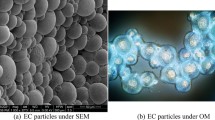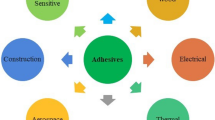Abstract
Interfacial strength between cement paste and an acrylic polymer, Poly(methyl methacrylate) (PMMA) primarily originates from the chemical interactions (formation of metal complex) between calcium ions of the cement paste and the ester functional group of PMMA. There are certain parameters, controllable at a construction site and can potentially influence the calcium characteristics of cement paste substrate, thereby affecting the interfacial strength. It is interesting to examine how these parameters can be engineered to enhance interfacial strength. To this end, the present work investigates the role of calcium on the interfacial strength between cement paste and PMMA by evaluating the influence of various parameters at early (2 days) and later (28 days) days of hydration. The parameters considered were w/c ratio, duration of curing, viscosity of PMMA, and use of lime coating. Macro-mechanical experiments such as slant shear and pull-off adhesion tests were performed to measure interfacial adhesive strength. Further, to understand the mechanism of calcium crosslinking in the absence of calcium ions, the effect of removal of pore solution from cement paste on interfacial strength was investigated. The experimental results indicate that the parameters considered have more influence on interfacial strength when PMMA was coated at the early age of hydration than coated at later ages. The trend observed in the interfacial strength is mainly ascribed to the variation in the concentration of calcium ions available for chemical interaction in the different conditions considered.











Similar content being viewed by others
References
Fowler DW (1999) Polymers in concrete: a vision for the 21st century. Cem Concr Compos 21(5–6):449–452
Reis JML (2006) Fracture and flexural characterization of natural fiber-reinforced polymer concrete. Constr Build Mater 20:673–678. https://doi.org/10.1016/j.conbuildmat.2005.02.008
Issa CA, Assaad JJ (2017) Stability and bond properties of polymer-modified self-consolidating concrete for repair applications. Mater Struct 50:28. https://doi.org/10.1617/s11527-016-0921-6
Haidar M, Ghorbel E, Toutanji H (2011) Optimization of the formulation of micro-polymer concretes. Constr Build Mater 25:1632–1644. https://doi.org/10.1016/j.conbuildmat.2010.10.010
Karbhari VM, Zhao L (2000) Use of composites for 21st century civil infrastructure. Comput Methods Appl Mech Engg 185:433–454. https://doi.org/10.1016/S0045-7825(99)90270-0
Mays GC, Hutchinson AR (1992) Adhesives in civil engineering. Cambridge University Press, Cambridge.
Almusallam AA, Khan FM, Dulaijan SU, Al-Amoudi OSB (2003) Effectiveness of surface coatings in improving concrete durability. Cem Concr Compos 25:473–481. https://doi.org/10.1016/S0958-9465(02)00087-2
Berndt ML (2011) Evaluation of coatings, mortars and mix design for protection of concrete against sulphuroxidising bacteria. Constr Build Mater 25:3893–3902. https://doi.org/10.1016/j.conbuildmat.2011.04.014
Arabzadeh A, Ceylan H, Kim S, Gopalakrishnan K, Sassani A, Sundararajan S, Taylor PC (2017) Superhydrophobic coatings on Portland cement concrete surfaces. Constr Build Mater 141:393–401. https://doi.org/10.1016/j.conbuildmat.2017.03.012
Beushausen H, Burmeister N (2015) The use of surface coatings to increase the service life of reinforced concrete structures for durability class XC. Mater Struct 48:1243–1252. https://doi.org/10.1617/s11527-013-0229-8
Pigino B, Leemann A, Franzoni E, Lura P (2012) Ethyl silicate for surface treatment of concrete - Part II: Characteristics and performance. Cem Concr Compos 34:313–321. https://doi.org/10.1016/j.cemconcomp.2011.11.021
Holck O, Bauer J, Wittler O, Michd B, Wunderle B (2012) Comparative characterization of chip to epoxy interfaces by molecular modeling and contact angle determination. Microelectron reliab 50:1285–1290. https://doi.org/10.1016/j.microrel.2012.03.019
Ilango NK, Gujar P, Nagesh AK, Alex A, Ghosh P (2021) Interfacial adhesion mechanism between organic polymer coating and hydrating cement paste. Cem Concr Compos 115:103856. https://doi.org/10.1016/j.cemconcomp.2020.103856.
Gujar P, Alex A, Santhanam M, Ghosh P (2021) Evaluation of interfacial strength between hydrating cement paste and epoxy coating. Constr Build Mater 279:122511. https://doi.org/10.1016/j.conbuildmat.2021.122511.
IS 12269, 2013 Ordinary Portland Cement 53 Grade-Specification Bureau of Indian Standards, India
ASTM C882, C882M-13a, 2015 Standard test method for bond strength of epoxy-resin systems used with concrete by slant shear West Conshohocken, United States https://doi.org/10.1520/C0882
ASTM D7234-05, 2005 Standard test method for pull-off strength of coatings using portable adhesion testers West Conshohocken, United States https://doi.org/10.1520/D7234-05.2
Barneyback RFJ, Diamond S (1981) Expression and analysis of pore fluids from hardened cement pastes and mortars. Cem Concr Res 11:279–285. https://doi.org/10.1016/0008-8846(81)90069-7
Wang M, Wang R, Zhenga S, Farhan S, Yao H, Jiang H (2015) Research on the chemical mechanism in the polyacrylate latex modified cement system. Cem Concr Res 76:62–69. https://doi.org/10.1016/j.cemconres.2015.05.008
Rothstein D, Thomas JJ, Christensen BJ, Jennings HM (2002) Solubility behavior of Ca-, S-, Al-, and Si-bearing solid phases in Portland cement pore solutions as a function of hydration time. Cem Concr Res 32:1663–1671. https://doi.org/10.1016/S0008-8846(02)00855-4
Lothenbach B, Winnefeld F (2006) Thermodynamic modelling of the hydration of Portland cement. Cem Concr Res 36:209–226. https://doi.org/10.1016/j.cemconres.2005.03.001
Zhang J, Scherer GW (2011) Comparison of methods for arresting hydration of cement. Cem Concr Res 41(10):1024–1036. https://doi.org/10.1016/j.cemconres.2011.06.003
Snellings R, Chwast J, Cizer O, Belie ND et al (2018) RILEM TC-238 SCM recommendation on hydration stoppage by solvent exchange for the study of hydrate assemblages. Mater Struct 51:172. https://doi.org/10.1617/s11527-018-1298-5
Dhandapani Y, Santhanam M (2017) Assessment of pore structure evolution in the limestone calcined clay cementitious system and its implications for performance. Cem Concr Compos 84:36–47. https://doi.org/10.1016/j.cemconcomp.2017.08.012
Fantinel F, Rieger J, Molnar F, Hubler P (2004) Complexation of polyacrylates by Ca2+ ions: time-resolved studies using attenuated total reflectance fourier transform infrared dialysis spectroscopy. Langmuir 20:2539–2542. https://doi.org/10.1021/la030354e
Filopoulou A, Vlachou S, Boyatzis SC (2021) Fatty acids and their metal salts: a review of their infrared spectra in light of their presence in cultural heritage. Molecules 26:6005. https://doi.org/10.3390/molecules26196005
Nagesh AK, Ilango NK, Alex A, Ghosh P (2020) Effect of pore solution calcium and substrate calcium on PMMA/cement paste interface during early stages of hydration. J Am Ceram Soc 103:4664–4677. https://doi.org/10.1111/jace.17104
Lau D, Buyukozturk O (2010) Fracture characterization of concrete/epoxy interface affected by moisture. Mech Mater 42(12):1031–1042. https://doi.org/10.1016/j.mechmat.2010.09.001
Buyukozturk O, Buehler MJ, Lau D, Tuakta C (2011) Structural solution using molecular dynamics: fundamentals and a case study of epoxy-silica interface. Intl J Solids Struct 48:2131–2140. https://doi.org/10.1016/j.ijsolstr.2011.03.018
Acknowledgements
The authors would like to acknowledge the financial support from the Department of Science and Technology, Govt. of India for supporting this work (Project File No. CRG/2019/003554). Sophisticated Analytical Instruments Facility (SAIF) and Pradeep's Research Group, IIT Madras are gratefully acknowledged for providing SEM and ICP-MS facility respectively. The authors would like to thank the Polymer Engineering & Colloid Sciences (PECS) laboratory, Department of Chemical Engineering, IIT Madras, Chennai, India for the assistance in viscosity measurements.
Author information
Authors and Affiliations
Corresponding author
Ethics declarations
Conflict of interest
The authors declare that they have no known competing financial interests or personal relationships that could have appeared to influence the work reported in this paper.
Additional information
Publisher's Note
Springer Nature remains neutral with regard to jurisdictional claims in published maps and institutional affiliations.
Supplementary Information
Below is the link to the electronic supplementary material.
Rights and permissions
Springer Nature or its licensor (e.g. a society or other partner) holds exclusive rights to this article under a publishing agreement with the author(s) or other rightsholder(s); author self-archiving of the accepted manuscript version of this article is solely governed by the terms of such publishing agreement and applicable law.
About this article
Cite this article
Gujar, P., Murali, N., Ilango, N.K. et al. Engineering interfacial strength of polymer coated hydrating cement paste by tuning calcium characteristics. Mater Struct 56, 65 (2023). https://doi.org/10.1617/s11527-023-02154-4
Received:
Accepted:
Published:
DOI: https://doi.org/10.1617/s11527-023-02154-4




